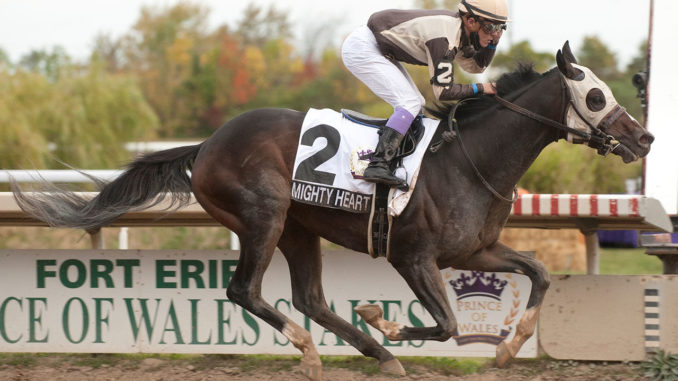
Let’s examine Mighty Heart’s predecessors and their Canadian Triple Crown bids.
When the term “Triple Crown” is uttered throughout the racing world, it’s sometimes easy to forget the influence Canada has had on the bloodlines of those that have won, or have come close to winning, its various incarnations.
A notable son
Canada’s most notable Thoroughbred son, Northern Dancer, won the Kentucky Derby and Preakness but fell short in his bid to sweep the 1964 Triple Crown when finishing third in the Belmont Stakes. However, his historic influence on the breed has been felt wherever the concept of a Triple Crown still exists.
…his historic influence on the breed has been felt wherever the concept of a Triple Crown still exists…
The most notable example was set by his own Canadian-bred son, Nijinsky, who in 1970 became the first horse in 35 years to win the English Triple Crown — the 2000 Guineas, Derby, and St Leger. The only horse to have attempted a sweep of the series in the last half-century, Camelot (2012), was a male-line descendant of Northern Dancer.
More successful among Northern Dancer’s direct male descendants were It’s a Dundeel, who swept the 2013 Australian Triple Crown consisting of the Randwick Guineas (G1), Rosehill Guineas (G1), and Australian Derby (G1). Justify, a fourth great-grandson of Northern Dancer, became the 13th and latest U.S. Triple Crown winner in 2018.
Although Northern Dancer is not a direct male line ancestor of Mighty Heart, there is plenty of his blood to be found in the pedigree of the Queen’s Plate and Prince of Wales Stakes winner. On Saturday, Mighty Heart will attempt to sweep Canada’s Triple Crown in the 1 1/2-mile Breeders’ Stakes at Woodbine, the Toronto-area course which is equivalent to the sun in the Canadian racing universe.
RELATED: Why Mighty Heart won’t win the Canadian Triple Crown
RELATED: Why Mighty Heart will win the Canadian Triple Crown
A new Woodbine
Indeed, the concept of the Canadian Triple Crown did not become fully formed until after the arrival of the “New Woodbine” in the latter half of the 1950s. The all-dirt “Old Woodbine,” later renamed Greenwood and now defunct, hosted the Queen’s Plate from 1883 through 1955 and the Prince of Wales briefly from 1953 through 1955. It was also the original home of the Breeders’, which was first held in 1889.
Northern Dancer’s owner, E.P. Taylor, could be said to be the guiding force behind the evolution of the Canadian Triple Crown into its present state. As head of the Ontario Jockey Club, Taylor was responsible for the opening of the new, world-class Woodbine and the consolidation of major racing in Ontario to it and its sister track Fort Erie. The introduction of turf racing at both venues also ensured that Canada’s version of the Triple Crown would be unique compared to similarly named series held in the rest of the world.
While sticklers might shake their heads at the restrictive nature of the Canadian Triple Crown, which is limited to 3-year-olds foaled in the country, it can’t be disputed how challenging the test is nor that a number of its winners proved more than capable when facing open company at other times in their career.
Five horses have been retroactively deemed winners of the Canadian Triple Crown — the filly Queensway (1932), Archworth (1939), Uttermost (1945), Ace Marine (1955), and Canadian Champ (1956) — but 1959 was the first year the series was truly recognized as such. The centennial edition of the Queen’s Plate (run as the King’s Plate in years when a male sat on the British throne) was held that June, with Queen Elizabeth II in attendance and New Providence fittingly prevailing for Taylor’s Windfields Farm.
While the general Plate conditions — 1 1/4 miles over the main track at Woodbine — had remained unchanged, the Prince of Wales found a permanent home that year at Fort Erie and was extended from 1 1/8 miles on dirt to 1 3/8 miles on turf. The Breeders’, which had been moved to turf two years earlier, was also lengthened, from 1 1/4 miles to 1 1/2 miles. The versatility of New Providence shone through that summer as the son of Bull Page swept the newly-configured Crown.
Another Windfields homebred, Canebora, took down the Triple Crown in 1963, but there was no chance of Northern Dancer giving Taylor the hat trick even before he bowed a tendon the following summer. With his lack of stamina exposed in the Belmont and the fact he was the best 3-year-old on both sides of the border, stretching back out for the Prince of Wales and Breeders’ while bypassing more lucrative U.S. races was unlikely in the cards.
None of the Canadian Triple Crown winners to that point had made any impact at the highest levels of North American racing, but that would change in the next wave of winners that came along after a drought of more than a quarter-century. It was perhaps no coincidence this wave came soon after the Prince of Wales was reduced in distance to 1 3/16 miles and moved back to dirt, making the series more closely resemble its southern counterpart.
With Approval and Izvestia, both homebreds racing for David Willmott’s Kinghaven Farms, swept their respective Triple Crowns in 1989 and 1990 under the tutelage of trainer Roger Attfield. With Approval did not race beyond the Breeders’ at age three, but as a 4-year-old in 1990 proved one of the top grass horses in the U.S. Only a streak of seconditis in the back half of the season, in races like the Arlington Million (G1) and Breeders’ Cup Turf (G1), prevented him from garnering an Eclipse Award. Although less successful in open company than his stablemate, Izvestia won the Molson Export Million at three and was a Grade 2 winner on the turf in the U.S. at age 4.
All of this was a prelude to the most celebrated Canadian Triple Crown winner of them all, the filly Dance Smartly. Campaigned by Ernie Samuel’s Sam-Son Farm, the daughter of Danzig (by Northern Dancer) swept all before her in 1991, tacking on the Molson Export Million (G2) and Breeders’ Cup Distaff (G1) to cap an 8-for-8 season. Not only was she named champion 3-year-old filly for all of North America, but also received support for Horse of the Year and was later inducted into the U.S. Racing Hall of Fame.
No less dominant in winning the Triple Crown two years later was Peteski, a son of Affirmed who gave Attfield his third series sweep, this time for owner Earle Mack. He, too, won the Molson Export Million, beating a field that included 1993 Kentucky Derby (G1) winner Sea Hero.
The most recent Triple Crown winner in Canada was Wando in 2003. Although no less a hero in Canadian racing circles, he proved a throwback to an earlier type of Triple Crown winner by being more competitive in stakes closer to home than in tougher events south of the border.
The complexion of the Canadian Triple Crown has changed significantly since Wando’s time. With the introduction of a synthetic main track at Woodbine in 2006, prospects must now master not two but three different surfaces. During this era, only the filly Wonder Gadot (2018) captured both the Queen’s Plate and Prince of Wales. However, she bypassed a shot at the Triple Crown in favor of an ultimately unsuccessful attempt at the Travers (G1).
While Mighty Heart fared poorly in his only previous try on turf last winter, he’ll be a sentimental choice to become the first horse to carry off Canada’s Triple Crown in 17 years. Whether or not he’ll ever subsequently rise to the level of the series’ very best winners, by winning the Breeders’ over a third different surface he’d carve out his own legend and occupy a unique place in the annals of Canadian Thoroughbred history.



